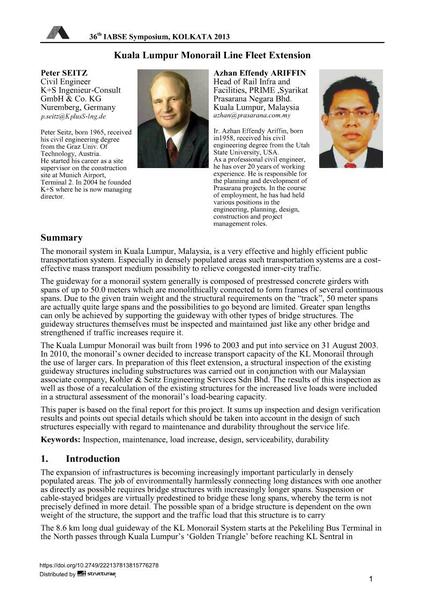Kuala Lumpur Monorail Line Fleet Extension

|
|
|||||||||||
Détails bibliographiques
| Auteur(s): |
Peter Seitz
Azhan Effendy Ariffin |
||||
|---|---|---|---|---|---|
| Médium: | papier de conférence | ||||
| Langue(s): | anglais | ||||
| Conférence: | IABSE Symposium: Long Span Bridges and Roofs - Development, Design and Implementation, Kolkata, India, 24-27 September 2013 | ||||
| Publié dans: | IABSE Symposium Kolkata 2013 | ||||
|
|||||
| Page(s): | 1-9 | ||||
| Nombre total de pages (du PDF): | 9 | ||||
| Année: | 2013 | ||||
| DOI: | 10.2749/222137813815776278 | ||||
| Abstrait: |
The monorail system in Kuala Lumpur, Malaysia, is a very effective and highly efficient public transportation system. Especially in densely populated areas such transportation systems are a cost- effective mass transport medium possibility to relieve congested inner-city traffic. The guideway for a monorail system generally is composed of prestressed concrete girders with spans of up to 50.0 meters which are monolithically connected to form frames of several continuous spans. Due to the given train weight and the structural requirements on the “track”, 50 meter spans are actually quite large spans and the possibilities to go beyond are limited. Greater span lengths can only be achieved by supporting the guideway with other types of bridge structures. The guideway structures themselves must be inspected and maintained just like any other bridge and strengthened if traffic increases require it. The Kuala Lumpur Monorail was built from 1996 to 2003 and put into service on 31 August 2003. In 2010, the monorail’s owner decided to increase transport capacity of the KL Monorail through the use of larger cars. In preparation of this fleet extension, a structural inspection of the existing guideway structures including substructures was carried out in conjunction with our Malaysian associate company, Kohler & Seitz Engineering Services Sdn Bhd. The results of this inspection as well as those of a recalculation of the existing structures for the increased live loads were included in a structural assessment of the monorail’s load-bearing capacity. This paper is based on the final report for this project. It sums up inspection and design verification results and points out special details which should be taken into account in the design of such structures especially with regard to maintenance and durability throughout the service life. |
||||
| Mots-clé: |
design
|
||||

